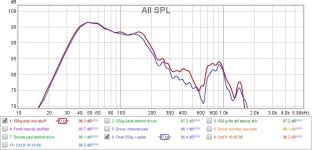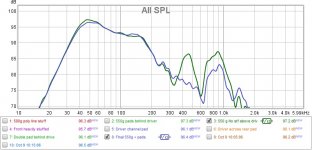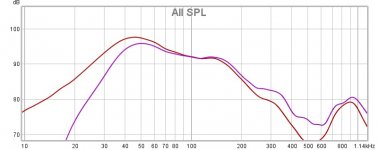FWIW - had some time this morning to experiment further. I removed all stuffing, teased it out further and re-stuffed in many different iterations.
This isn't new information by any stretch, but any stuffing close to terminus showed a significant reduction in low bass.
What intrigued me is that I had difficulty making any modification that noticeably impacted the ~900 hz peak. I even drilled bigger holes in one of the side braces as I thought maybe there was some sort of standing wave occurring.
At one point I heavily stuffed the front half of the cabinet, and this started to show improvement, but then also reduced low bass to a similar extent. Interestingly, stuffing in the rear half of the cabinet didn't show the same effect. Stuffing the lower half of the cabinet tended to impact low bass (i.e. 50hz), while upper portion stuffing tended to impact more around mid-bass, low-mid range.
Where I seemed to make some progress, or at least saw some interesting effects, was using a couple of pieces of compressed polyester batting (approx 5x7 inch x 2 inch depth) in different places. Putting these at the rear of the cabinet hard against the back wall behind the driver showed a repeatable reduction of around 3-4db around 3-500hz. I then added horizontal pieces directly beneath the driver on each side of the brace. This had the most noticeable impact on the higher ~900hz peak while not significantly impacting low bass. Interestingly, this effect was not replicated by putting the pads in the same orientation above the driver.
For now at least, I settled on 550g of polyfill evenly distributed throughout the line with the polyester 'pads' both behind (rear wall) and below the driver (around 1 inch below laying parallel to base/top).
In the first graph, where I started can be seen in red, and where I ended up; in blue. While not radically different, it should be noted that almost every other variation of stuffing I tried served to exacerbate the ~900hz peak.
The other graph I included for fun. It was the 'worst' response I managed to achieve by removing all the stuffing from around the driver and above, while retaining the lower stuffing.
If I feel inspired, the next experiment may be using strategically placed pieces of the denser polyester batts in the lower portion of the cabinet in place of the polyfill. Again, I'm not sure how vent output interacts with in-room driver FR, but would assume that there is an 'optimum' or at least, more desirable roll-off.
Matt
This isn't new information by any stretch, but any stuffing close to terminus showed a significant reduction in low bass.
What intrigued me is that I had difficulty making any modification that noticeably impacted the ~900 hz peak. I even drilled bigger holes in one of the side braces as I thought maybe there was some sort of standing wave occurring.
At one point I heavily stuffed the front half of the cabinet, and this started to show improvement, but then also reduced low bass to a similar extent. Interestingly, stuffing in the rear half of the cabinet didn't show the same effect. Stuffing the lower half of the cabinet tended to impact low bass (i.e. 50hz), while upper portion stuffing tended to impact more around mid-bass, low-mid range.
Where I seemed to make some progress, or at least saw some interesting effects, was using a couple of pieces of compressed polyester batting (approx 5x7 inch x 2 inch depth) in different places. Putting these at the rear of the cabinet hard against the back wall behind the driver showed a repeatable reduction of around 3-4db around 3-500hz. I then added horizontal pieces directly beneath the driver on each side of the brace. This had the most noticeable impact on the higher ~900hz peak while not significantly impacting low bass. Interestingly, this effect was not replicated by putting the pads in the same orientation above the driver.
For now at least, I settled on 550g of polyfill evenly distributed throughout the line with the polyester 'pads' both behind (rear wall) and below the driver (around 1 inch below laying parallel to base/top).
In the first graph, where I started can be seen in red, and where I ended up; in blue. While not radically different, it should be noted that almost every other variation of stuffing I tried served to exacerbate the ~900hz peak.
The other graph I included for fun. It was the 'worst' response I managed to achieve by removing all the stuffing from around the driver and above, while retaining the lower stuffing.
If I feel inspired, the next experiment may be using strategically placed pieces of the denser polyester batts in the lower portion of the cabinet in place of the polyfill. Again, I'm not sure how vent output interacts with in-room driver FR, but would assume that there is an 'optimum' or at least, more desirable roll-off.
Matt
Attachments
As an update to this thread - I've come to realise that some of my earlier challenges around bass output actually were related to my amp rather than the stuffing. As my main amp was getting serviced at the time, a lot of my stuffing experiments were using a cheap class D amp that I had on hand.
As can be seen from from the attached graphs, the bass extension and output on my main amp (a vintage Nakamichi) is significantly different than the cheap fill-in. Accordingly I have needed to add back significantly more stuffing to tame the low bass. At a guess I'm probably back in the 700-800g range (recommended is 1250g), and it still needs more. I still have a block of more dense acoustic batting sitting under the driver against the front baffle which shows a noticeable reduction in the ~900hz resonance. Probably some more dense packing of polyfil in that region would achieve the same result.
As an aside I'm currently listening to a new album by Blake Mills and Pino Palladino ("Notes with attachments") which sounds great on these Pensils.
Matt
As can be seen from from the attached graphs, the bass extension and output on my main amp (a vintage Nakamichi) is significantly different than the cheap fill-in. Accordingly I have needed to add back significantly more stuffing to tame the low bass. At a guess I'm probably back in the 700-800g range (recommended is 1250g), and it still needs more. I still have a block of more dense acoustic batting sitting under the driver against the front baffle which shows a noticeable reduction in the ~900hz resonance. Probably some more dense packing of polyfil in that region would achieve the same result.
As an aside I'm currently listening to a new album by Blake Mills and Pino Palladino ("Notes with attachments") which sounds great on these Pensils.
Matt
Attachments
As an update to this thread - I've come to realise that some of my earlier challenges around bass output actually were related to my amp rather than the stuffing. As my main amp was getting serviced at the time, a lot of my stuffing experiments were using a cheap class D amp that I had on hand.
As can be seen from from the attached graphs, the bass extension and output on my main amp (a vintage Nakamichi) is significantly different than the cheap fill-in. Accordingly I have needed to add back significantly more stuffing to tame the low bass. At a guess I'm probably back in the 700-800g range (recommended is 1250g), and it still needs more. I still have a block of more dense acoustic batting sitting under the driver against the front baffle which shows a noticeable reduction in the ~900hz resonance. Probably some more dense packing of polyfil in that region would achieve the same result.
As an aside I'm currently listening to a new album by Blake Mills and Pino Palladino ("Notes with attachments") which sounds great on these Pensils.
Matt
It's probally due to the damping factor of the class D amp. Some very cheap have a very low damping factor, while class A or AB mostly have a rather high damping factor. Cable length, crossover (if there is any) and driver also are into play here, but if you only swapped the amp, it's probally due to that.
And in my experience, the CHN110 did not like my SMSL SA36 class D amp, with also a more boomy unaccurate bass response. But with the ACA (class A transistor), the Prima Luna Prologue 4 (class AB tubes) and the Marantz PM5004 (class AB transistor) that is not an issue. Idem with my other Mark Audio fullrange drivers (Alpair 10.3). I use that SMSL mainly to test speakers or for in my workshop (where i have some old Philips AD1065 FR drivers in an old subwoofer cabinet just to have music there). And those Philips FR's also prefer the other amps (but in a noisy workshop it does not matter that much). With multiway speakers where the crossover is adding damping it's not an issue it seems.
That's interesting - lots more to learn here regarding full range drivers by the sounds. I'm also curious to understand more about how speaker impedance interacts with an amplifier (output/damping factor?) in these designs (i.e. MLTL single driver), as it seems that shaping the impedance curve is a salient part of design consideration.
First lets lose the term damping factor. It is a marketing way of expressing a low amplifier output impedance Rout into a large number.
A low Rout amplifier (ie one with high damping, note anything above about 20 is meaningless in the real world), will not be affected much by the loudspeaker impedance.
As Rout gets larger the speaker’s impedance starts to affect the loudspeaker frequency response. Everywhere the impedance goes higher the F with also show a rise.
In FR speakers, impedance is usually pretty flat except at the bottom where the driver resonance causes am impedance rise, sometimes by alot. Wild impedance at higher frequencies is usualluy caused by the XO.
THis means that the amp will affect the bass response. Speakers like the Pensil & FHs allow for adjustment to add mechanical damping to the box in those cases helps to optimize for the A low Rout of the amplifier.
dave
A low Rout amplifier (ie one with high damping, note anything above about 20 is meaningless in the real world), will not be affected much by the loudspeaker impedance.
As Rout gets larger the speaker’s impedance starts to affect the loudspeaker frequency response. Everywhere the impedance goes higher the F with also show a rise.
In FR speakers, impedance is usually pretty flat except at the bottom where the driver resonance causes am impedance rise, sometimes by alot. Wild impedance at higher frequencies is usualluy caused by the XO.
THis means that the amp will affect the bass response. Speakers like the Pensil & FHs allow for adjustment to add mechanical damping to the box in those cases helps to optimize for the A low Rout of the amplifier.
dave
- Home
- Loudspeakers
- Full Range
- CHN 110 Pensil - stuffing effects




